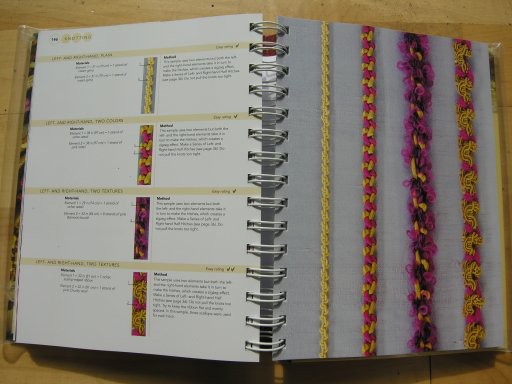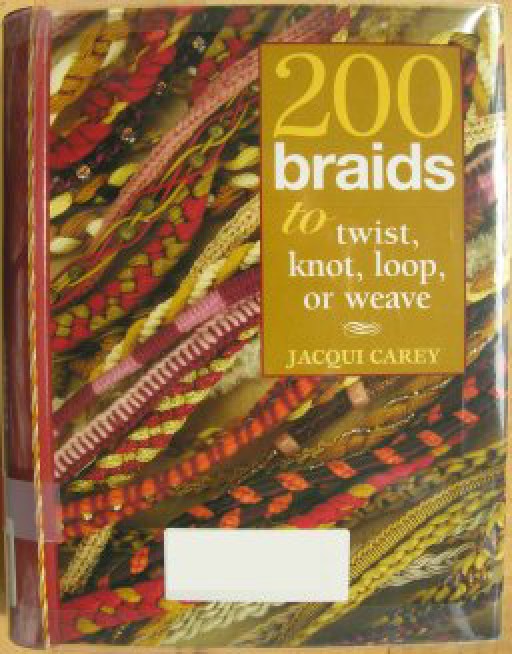Ok, so since this book was due back at the library yesterday, I
suppose I now have to get off my duff and say something about it. 200 Braids by Jacqui Carey is a relatively small comb-bound
hardcover of 256pp, which despite the title is mostly about other
cord-making techniques: if you're only interested in braid-making, I
recommend either her Kumihimo for Beginners, or if you've even just
a little confidence of your abilities to learn out of books, go
straight to her excellent, if somewhat poorly copy-edited, Creative
Kumihimo. Those books, and 2 others strictly about kumi are reviewed
in the old kumihimo post. Updated, more friendly link;)
This book, by contrast, is a survey of a variety of cord-making techniques (including simple braiding). It starts out with a very brief introduction and historical sample gallery (alas, only two images!) before going into a review of yarns, a term the author applies to all fibers, including ribbons, that used to make the “narrow wares” in this book.
‘Element’ is the term she uses for what kumists traditionally call multiple ends, that is, more than one strand treated as a single unit for construction purposes. She also discusses beads, primarily seed bead (cylindrical) types, whith a brief mention of chips.
The next section covers technique, including twisting, knotting, interlooping, weaving, and finally, the section of greatest interest to me personally, what she calls ply split darning, though I belong to Collingwood's camp in calling the technique ply split weaving. The twisting section, for those of you unwilling to blow $200 plus on a bradshaw winding machine, offers helpful hints in the form of sticky tape for managing multiple strands you've already made while your drill is busy with the current one.
The knots and sinnets, as might be expected, are all very simple, incorporating 2, 3 or 4 cords, with variations that include beads or floats to surprisingly good effect. (In fact, though I was very happy to see my question about square crown sinnets vis a vis Sharing Knife answered, this 4 strand sample struck me as the slowest to make, and least practical from that point of view; I liked the pieces using two contrasting cords knotted around a third core the best, or even two cords knotted around them selves in alternating pattern, better.
The looping section has samples using fingers, a lucet and a 4 nail knitting noddy. Again, I found one of the simpler approaches using a single cord, two loops and fingers, to be the most attractive, though my preference for smooth round cord, as opposed to the slinky flat ribbon used to demonstrate the knitting noddy may have had an effect.
The braiding section, for which the most expensive tools—an inkle loom, kumi bobbins (tama) and a lacemaking pillow—were shown, basically resolved to two techniques: a fixed-warp (traditional) weft faced tabby weave, and oblique interlacing (i.e. braiding) using either the hands or bobbins on a lace pillow. (Um, if you're like me, just remember the wefts go weft to right, i.e. side to side, and the warps are the long strands fixed to the top and bottom of the loom. Thus oblique interlacing is merely a fancy way of saying, ‘weaving on the diagonal, with the strands changing from wefts to warps depending upon position. ’Kay?)
Ply split darning included one approach: the wefts are threaded thru the warps, making for a warped faced cord. This technique, used only by camel herders for centuries, lends itself very well to the book's parameters of minimal equipment or experience. The technique section touches on some tips for dealing with beads, especially seed beads, including the use of a bead spinner. Carey, not surprisingly, has a lovely varnished wooden one, but those are pricey. You can make your own out of margerine tubs, so I recommend a little poking around the web for cheap subsitutes if you're wanting to keep your initial investment on the inexpensive side. There's also very brief instructions on tassels and end finishing. Finally, there's a brief howto/gallery for using your new goodies, as closures for buttons, trim, etc.
Section two, the samples, opens with a 10 page section of thumbnails, with relevant page numbers of each cord in the book, which I thought extremely helpful. I couldn't help thinking the author (or publisher) had taken a leaf from web galleries. At any rate, it makes for a fast and easy way to compare projects before you decide on one. The remainder of the book is subdivided into the 5 sections above, with four samples shown full sized or enlarged on the right, with materials required, instructions, and difficulty level shown on the left. Each page of samples usually shows if not the same, then very similar technique, but worked witha variety of cords, generally with the simplest and smoothest coming first, and gradually increasing in fiber complexity.

I've downgraded the resolution of this not-very-nicely photographed page to fall within fair use, but you can see my favorite knotted cord (with fuzzy yarns no less!) and get a sense of how the construction pages are laid out.
One of my favorite knotted cords, for example, was made with scalloped gimp cord (think victorian lampshade trim) and fuzzy yarn. This illustrates a principle the author touches upon: that cord making is, or rather can be, very much an interative process: you make a somewhat fancy cord, then incorporate that as an element into another cord.
To be perfectly honest, I was a tiny bit disappointed with the book when I first went through it. Of all the projects in it, only one, a mixed width flat ribbon braid, rated three checkmarks for difficulty; the rest were one or two. (I take it back. I found a spectacularly ugly glitter braid with dull dusky rose pony beads that also gets three checkmarks. Which leads me to another point: as in the past, I haven't cared for most of Carey's beaded braids, and though I liked some of the ones using beads as edging or picots very much, her facility with larger beads still leaves something to be desired.)
Looking over it again, now having gotten over my disappointment on the lack of fancy cords, it's easier for me to point out the book's strengths: the low barrier to entry; excellent organization (helped by Carey's mathematical understanding of the structure of these cords); nice design and color scheme; good photography. The comb binding lays nice and flat, always good in a ‘recipe’ book of this type. The tiny print in the instructions (5 point?) will not be loved by those with aging eyes, but I suppose they'll have magnification to work with the materials anyway.
These projects could be easily adapted to a group setting for adults or children, and are a fun introduction for people who'd like to try a variety of off loom textile techniques with low expense, and a very nice illustration of the difference tension and fiber can make in the final product. People hoping for a large gallery of historical samples or detailed instructions on how to make complex traditional passementarie will need to keep looking, however.
file created 25may07
Unless otherwise noted, text, image and objects depicted therein copyright 1996--present sylvus tarn.
Sylvus Tarn